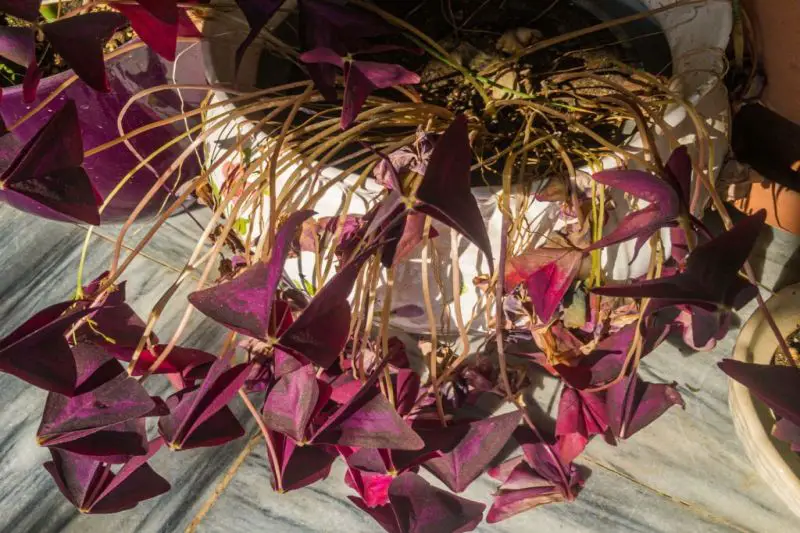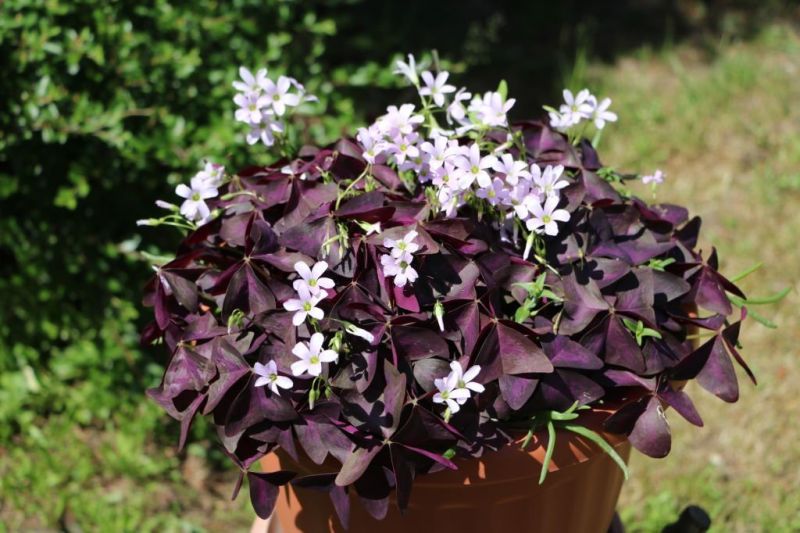Your oxalis is drooping for a number of reasons. It might be that you’re overwatering it. If your potting soil is too wet, you’ll get root rot and your plant will begin to droop. This can also happen if you don’t water enough. The other thing to look at is the temperature in your home. If your house is too cold or too hot, it can have an effect on your plant’s health.
Oxalis is a beautiful flowering plant that grows in most parts of the world. It’s considered a weed by many gardeners, but it can be useful as an ornamental plant in the right setting. Oxalis needs plenty of sunlight and well-drained soil to thrive, so if your oxalis is drooping, there may be some easy fixes you can try before resorting to drastic measures.
Let’s dive deep into why Oxalis droop and how to revive it!
Overwatering
Overwatering is one of the most common causes of drooping oxalis.
This plant is very sensitive to being overwatered. If you notice your plant drooping, it’s probably because you’ve been watering it too much.
The plant needs to be watered only when the top inch or so of soil is dry, and even then, it should be watered with a very gentle hand. If you’re using a watering can or watering wand, do not direct the water at the base of the plant—only apply water to the top layer of soil. If you’re using a sprinkler or hose, make sure that no part of your oxalis gets more than a light misting.
Another way to avoid over-watering is to use a moisture meter. These devices are relatively inexpensive and allow you to monitor how much moisture is in the soil around your oxalis without having to resort to guesswork.
Not enough sunlight
Oxalis is a plant that can thrive in partial shade, but it does best in bright, indirect sunlight.
The sun is what gives your oxalis its energy, which allows it to grow strong stalks with thick stems and large leaves filled with chlorophyll. When you don’t give your plant enough light over time, those stalks become weak and thin out until they can’t support the rest of the plant anymore. Then gravity steps in and pulls everything down toward the ground!
So be sure to keep your oxalis in a place where it gets plenty of sunlight every day.
Transplant shock
Transplant shock is a common problem that can occur when you transplant a plant from one pot to another. It’s typically characterized by drooping leaves, yellowing leaves, and brown spots on the leaves.
Transplant shock is due to the shock of being moved from one environment to another, so it’s not a disease or an infection. The plant isn’t getting enough water or nutrients, which is why its leaves are drooping.
If you’ve recently transplanted your oxalis, it’s important to make sure that the plant has adequate water and light.
So make sure the soil around the roots is moist but not wet, don’t let it dry out completely but also don’t try to force too much water into the ground. In a few days, your oxalis should be healthy again!
Humidity issues
If your oxalis is drooping, the most likely cause is humidity. Oxalis is a tropical plant, and it will thrive in very warm, humid conditions. When the humidity of your home is too low, your oxalis will be affected. The ideal range for oxalis is 70-80% and this can be achieved by watering them in the morning or evening when it’s cooler. If you’re in a dry climate and want to increase humidity, mist your plant once or twice a day. If you live in a humid climate and want to decrease humidity, reduce watering frequency.
Dormancy Period
You may have noticed that your oxalis is drooping. This could be because of dormancy, which happens every fall. Your oxalis will go into a state of hibernation, and it will start to look like it’s dying. But don’t worry this is totally normal! In fact, if you were to water your oxalis during dormancy, you could actually kill it.
So how do you know if your oxalis is in dormancy?
Easy just look for the following signs:
- It stops growing completely
- Its leaves turn yellow or brown
- The plant’s stems become dry and brittle
If you’re seeing any of these signs in your oxalis, then congratulations! Your plant is going through its yearly cycle of rest and rejuvenation. Just keep it in a cool, dark place with minimal water until February or March depending on where you live, and then bring it back outside when the weather warms up and give it plenty of water once more. You’ll see new growth by June or July again!
Poor Drainage
If your Oxalis is drooping, the problem may be poor drainage. If your plant’s roots are not able to drain the water away, they will rot and die. This can happen if the soil is too heavy or too deep.
If you suspect poor drainage is the cause of the problem, you should transplant your plant into a pot with better drainage. You can also improve drainage by adding some sand or perlite to the soil mix.
Too much heat
Too much heat will cause the plant to wilt and droop. If you’re growing your oxalis outside in the summer, it can get really hot out there!
So make sure that you keep an eye on your plants and water them when they need it and move them into a shadier spot so that they don’t get too much sun.
Over Fertilizing
If you’re noticing that your oxalis has started to droop, it’s possible that you’ve over-fertilized your plant. Oxalis are extremely sensitive to fertilizer and can easily burn and die if they’re not given just the right amount.
To keep this from happening, try using a balanced houseplant fertilizer. These fertilizers will have a low nitrogen content, as too much nitrogen can cause fast growth that will lead to droopy leaves.
Disease or Pest infestation
Pests are a common problem for Oxalis. The most common culprits are aphids, whiteflies and mealybugs. The best way to get rid of these little guys is to spray them with soapy water until they fall off. If you see an infestation, you can also try using a pesticide like neem oil. Be sure to use this carefully and follow the directions carefully.
There are a few different kinds of diseases that can cause oxalis to droop, and they all have different signs and symptoms.
Powdery Mildew: Powdery mildew is a fungus that can infect the leaves of your Oxalis and cause them to turn yellow and fall off. If this is the culprit, you should remove the infected leaves as soon as possible—the fungus will spread from one leaf to another if left unchecked.
Root Rot: Another possibility is root rot, which happens when too much water gets into the soil around your plant’s roots. This can cause the roots to rot, which can lead to wilting or even death if left unchecked. To prevent this from happening, make sure that you keep your plant in well-drained soil at all times.
Leaf Spot: Leaf spot can also lead to drooping in your Oxalis. Leaf spot occurs when there are fungal spores present on the leaves of your plant; these spores will spread when they get wet and can eventually kill your plant if not treated quickly enough. To treat leaf spot, you should use an anti-fungal spray on the infected areas.[su_youtube url=”https://www.youtube.com/watch?v=GJqlo7SyBQk” width=”500″ height=”360″]
Conclusion
Well, I hope you’ve enjoyed this article on why your oxalis is drooping. It’s a common problem, but it doesn’t have to be! If you follow these tips, your houseplants will be healthy and happy in no time at all 🙂
Also Read: Fatsia Japonica Yellow Leaves? Here’s Why & How to Prevent It

